#german rocket fighters
Explore tagged Tumblr posts
Text

One of a handful of photos taken of the Messerschmitt Me 163B Komet rocket fighter in action. Boeing B-17F Flying Fortress in foreground is not part of the original photo, it was added to Humphrey Bogart's 1950 film, Chain Lightning. For more, see my Facebook group - Eagles Of The Reich
#germany#ww2#luftwaffe#ww2 aircraft#messerschmitt#me 163 komet#german rocket fighters#me 163#b 17#heinkel#flying fortress#1943
158 notes
·
View notes
Text
Arab blogger Hoda Jannat exposed the lies in a series of posts on the X social media platform, together with video footage to substantiate his claims.
1. We suddenly discovered that there are 36 hospitals in the Gaza Strip, where 2 million people live. There are Arab countries with a population of 30 million people, where there are not many hospitals.
2. Surprisingly, but we discovered that Gaza gets free water, electricity, gas, and fuel from Israel. Of course, there is not a single Arab citizen anywhere in the world who doesn't pay for water, electricity and gas.
3. We suddenly found out that Gaza gets 30 million dollars a month from Qatar alone. And 120 million dollars a month from UNROP. And 50 million dollars a month from the European Union. And 30 million dollars a month from America. There are Arab countries that are drowning in debt and cannot find anyone to give them at least a million dollars.
4. Suddenly we discovered that there is no “siege” on Gaza and all goods are flowing there and the borders are open. The people of Gaza went to Egypt, and from there around the world.
5. Suddenly, we discovered that Arabs live better in Gaza than in many Arab countries.
6. Suddenly, we discovered that our minds have been programmed by the lies of the Muslim Brothers media.
7. Suddenly, we discover that the children in Gaza are not the children we usually imagine, but the children of terrorists with rifles and death belts trained by Hamas.
8. Suddenly, we discovered that there are terrorist headquarters and ammunition warehouses with Hamas underground tunnels organized in Gaza schools, hospitals and mosques.
9. We have suddenly discovered that there is an underground Hamas subway of over 500 km long in Gaza, which Israel can only envy.
10. Suddenly, we discovered that so-called doctors and teachers in the Gaza Strip turned out to be active Hamas terrorists.
11. We suddenly discovered that rockets and mortars are stored in the children's rooms of Gaza homes.
12. We suddenly discovered that Hitler and his book "Mine campf" were very popular in Gaza and its Arabic translation was in almost every home in Gaza or portrait of the author.
13. Suddenly, we discovered that the leaders of Gaza live a luxurious life with high-rise mansions with swimming pools and premium German cars.
14. We suddenly discovered that there is no Israeli blockade in the Gaza Strip, as it still borders its Muslim sister, Egypt.
15. We have suddenly discovered that most "citizens" in the Gaza Strip support Hamas and other terrorist groups, elected Hamas in democratic elections and celebrated the October 7th massacre.
16. We have suddenly discovered that the so-called reporters and journalists in the Gaza Strip working for western media CNN, AP, Reuters and others turned out to be the Hamas terrorists involved in the October 7 massacre.
17. We have suddenly discovered that the so-called "peace fighters" and "international human rights organizations workers" of the UN, Red Cross, and WHO turned out to be terrorists and corrupt Hamas.
18. We have suddenly discovered that each of the Hamas leaders is a billionaire and richer than President Trump, with equity of $4-5 billion each.

#israel#secular-jew#jewish#judaism#israeli#jerusalem#diaspora#secular jew#secularjew#islam#Hamas#gaza#fuck hamas#islam is a death cult#cult#hamas is isis#hamas war crimes#Hezbollah#gaza lies#Pallywood#Hoda Jannat
46 notes
·
View notes
Text

1943 05 Swordfish rockets 816 NAS- Roy Cross
By May 1943, No. 816 NAS was a seasoned Royal Navy Fleet Air Arm squadron with a history of anti-submarine and anti-shipping operations. Originally formed in October 1939 aboard HMS Furious with Fairey Swordfish for convoy protection, the squadron had seen action in multiple theaters, including Norway (1940), the Mediterranean (1941), and the Atlantic (1943). In early 1943, it was operating with Swordfish, likely the Mark II variant, which had been introduced that year with metal lower wings capable of mounting rockets—a significant upgrade for attacking surface targets. The squadron’s base of operations during this period is less certain, but it was likely shore-based at a southern England airfield, such as RAF Perranporth in Cornwall or RAF Manston in Kent, or possibly detached to an escort carrier like HMS Tracker or HMS Chaser, both of which it served aboard at various points in 1943.
The English Channel in May 1943 was a critical theater for disrupting German maritime supply lines, particularly as the Allies prepared for the eventual invasion of northwest Europe. German shipping in the Channel included coastal convoys, E-boats (Schnellboote, fast attack craft), and smaller vessels supporting the Atlantic Wall defenses. No. 816 NAS, with its Swordfish, would have been tasked with targeting these vessels, often under Coastal Command’s direction, to degrade German logistics and protect Allied shipping. The Swordfish’s ASV (Air-to-Surface Vessel) radar, operational since 1941, allowed it to locate targets in darkness or poor weather, making night missions a hallmark of its operations.
Equipped with rockets or bombs (torpedoes were less common against smaller Channel targets), they would patrol a sector between Start Point and Ushant, hunting for a German convoy reported by reconnaissance or Ultra intelligence.
In such a mission, the Swordfish would fly low, around 50-100 feet, using ASV radar to detect a target—say, a group of armed trawlers or an E-boat flotilla escorting supplies from Cherbourg to Boulogne. Upon sighting, the lead aircraft might signal an attack, climbing to 500 feet to fire rockets in a shallow dive, aiming to disable engines or ignite fuel stores. The others could follow with 250-lb bombs, targeting additional vessels or scattering the convoy. Success might be sinking one or two ships (100-500 tons each) or forcing the rest to disperse, with the flight returning under cover of darkness to avoid Luftwaffe interception. Losses were a risk; a Swordfish could be downed by flak or a night fighter, though German air cover in the Channel was waning by mid-1943.
20 notes
·
View notes
Text
Arcane OC 1 — Charlotte
Charlotte became orphaned at the age of 10 after her mother's passing due to an untreated illness, she fended for herself until the age of 13 when she met Vi who made her acquainted with Vander.
Vander didn't take her in but he made sure she was properly cared for and she spent a lot of time with Vi and the rest of the gang.
She never joined them on robberies, she preferred to pickpocket both Zaunites and Piltovians and selling what she took for cash.
After the incident at the warehouse, she was met with a crossroad, go after Vi or go after Powder. But she knew Vi would want her to make sure Powder was okay.
So she tried to save her. But failed.
Silco slit her throat and left her for dead, however she was found just in time by enforcers who took her to a hospital in Piltover where she spent 4 months (mainly unconscious and comatosed) and her 16th birthday.
She managed to run away from the hospital a few days after waking up.
With nothing and no one left she got into pit-fighting, settling into the pit with the intent of death.
She was fighting for almost two years, becoming one of the best fighters of the business, until she met her match one day when she was 18.
Beat almost to death and back in hospital, highly concussed she realised she didn't want to die.
But, after going back to the pit after she recovered (and got drunk the night before leaving her with an awful hangover) the manager/owner asked her if she was ready for her next fight. But he was (un)pleasantly surprised when she told him she wanted to quit.
However at the start of her career, she signed a contract (including both a signature and blood fingerprint) that bound her to the pit for five years.
But since she had only done two years, the manger said she could either continue and fight for the next three years or cut the tie to the contract, to which he placed a knife infront of her.
After consideration she realised her only option was to cut the tie, to which she pulled out her own pocketknife, which used to be her mother’s, and cut off her finger which she used for the bloody fingerprint.
Her left ring finger.
After this, she left the building and cried in the back alley behind the place, for a good while too, before she forced herself up. She beat up and robbed one of Silco’s goons, going into another alley to take a small sip of the shimmer to ease the pain of her missing finger before throwing the vial (and its remaining contents at the wall).
Throughout all these times she stayed where she lived with her mother but often slept leaning on the makeshift grave she'd made for her mother.
But eventually, she got an apartment and cleared her life up. At 21 she had her first time with Rose at the brothel who she eventually kept sleeping with.
However the pair became involved with each other a little too much and caught feelings. Nothing changed between them though.
At 22 she bumped into Vi (and Caitlyn) in an alleyway near Jericho's food stall, she was fussing a stray German Shepherd puppy which is later seen in her apartment, in the war and in the epilogue. Vi and Charlie had a reunion and she accompanied them to the brothel, splitting up there as she went to see Rose.
She only reunited with Vi when she was going back to Zaun with the huge gauntlets attached to her fists.
Charlotte didn't get kidnapped by Jinx unlike Vi and Cait. Jinx liked her, and she was okay with Jinx. They weren't exactly friends anymore but they didn't hate each other.
In season two, Charlotte went to Piltover after the rocket was launched, only to find Vi drunk on a fountain with some other guy.
Then of course Maddie appeared, Charlie didn't like her. Immediately was suspicious of her and her smug demeanour.
She didn't join the enforcers with Vi and expressed her disappointment in Vi for doing so. Her and Vi had an argument and she stormed off.
In the meantime she went to her apartment where we see Rose for the first time and begins to rant about Vi and how she would go against her morals just like that. Rose comforts her before Charlie leaves to go and find Jinx.
She goes to where they used to hide from enforcers, finding Jinx making an arm for Sevika. She has a conversation — that starts as an argument — as to why she launched that rocket and did what she did in the first place.
Eventually they realise that they're utilising the Grey and go and hide, Charlie is both angry and disappointed upon seeing Vi actually wearing the enforcer uniform.
When she notices Jinx's tear fall she moves her hand to over her mouth and puts another finger to her own mouth in a shushing gesture to stop Jinx from sobbing.
When they leave, Jinx runs off with Sevika's arm and Charlie goes in the opposite direction after asking if she was alright, though she takes the option of going across the rooftops so she's not seen by Vi and the others.
However she is reunited with Vi a few hours later when she was on her knees sobbing after Caitlyn left, she comforts Vi and tells her she can stay in her apartment for as long as she needs.
In act two, Charlie doesn't play a major role other than cleaning Vi up after she goes on her pit-fighting arc. She once again expresses her frustration with Vi at her stupid decisions and tells Vi about how she got into pit-fighting and almost died.
Vi doesn't really listen, being drunk so Charlie bids her goodbye and leaves.
She is also seen alongside Rose in the alternate universe in Ep.7 where she is much closer to Powder like she is with Vi in the normal universe.
In act three, she finally asks Rose out on a proper date where they go to a club. A man almost assaults Rose and she gets into a physical fight with him, almost killing him before she is finally dragged out and Rose follows.
Rose is enamoured by her display of affection (and strength) and kisses her, properly.
They then go back to her apartment where Rose insists upon patching up her injuries before they eventually have sex.
Charlie arrives late to the meeting with Vi, Cait, Mel and Jayce and delivers a smooth apology, though everyone knows what happened (she's not subtle).
Whereas Rose joins Ekko and Jinx.
Charlie fights alongside everyone else, as does Rose.
However Charlie fights — or attempts to fight — Viktor's robots and fails miserably, hence the dog getting involved. In the fight, the dog (Tex) gets stabbed and slashed across the eye.
Charlie does not like that at all, and starts fighting recklessly against the robot. She gets both her arms and nose broken as well as a few ribs amongst other minor injuries. Plus a concussion, all of which leaves her unconcious until Rose finds her — and Tex — and shouts for help.
After the war, in the epilogue, we see the two wrapped up in bed together, Rose's head on Charlie's chest, and Tex — now missing her eye — with her head on Charlie's stomach, as Charlie tells Rose she's the prettiest girl she's ever seen.
SIDE NOTE: charlie would also be a champion in league bc i said so, also ignore the sloppy writing 😛 and this is only gonna be up for about a day
this was kind of (?) requested by:
https://www.tumblr.com/ghostofapocrypha
(it won’t let me tag them idk why 😭)
but i thought id make a post so its more visible
#arcane#arcane oc#oc#my oc#arcane original character#original character#arcane lol#league of legends oc#league of legends#lesbian#wlw#sapphic
7 notes
·
View notes
Photo
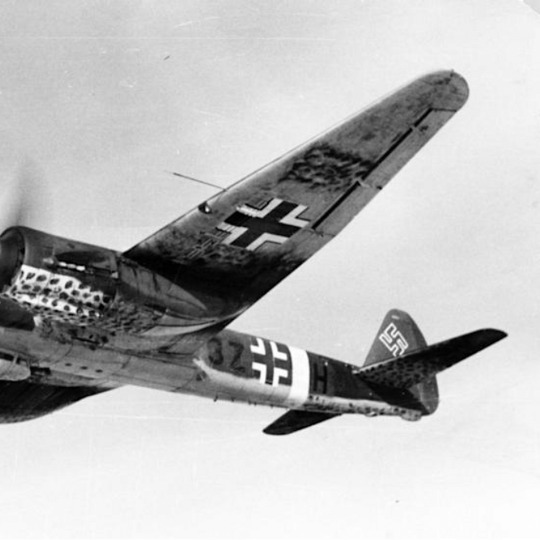
Junkers Ju 88
The Junkers Ju 88 was a two-engined medium bomber plane used by the German Air Force (Luftwaffe) throughout the Second World War (1939-45). Ju 88s were involved in the Battle of Britain and London Blitz as bombers, but this versatile aircraft saw action in many other theatres of the war, primarily as a dive bomber and a night fighter.
Design Development
After much debate between the German high command and the Nazi leader Adolf Hitler (1889-1945), the Luftwaffe bomber command (Kampfwaffe) was obliged to adopt the position that bombers should primarily be used strategically to assist ground troops. This meant that unlike, say, the British Royal Air Force, the Luftwaffe concentrated not on heavy bombers but building squadrons of more versatile medium bombers.
In August 1935, aeronautical companies were invited to provide an answer to the German Air Force's requirement for a two-engined, medium-sized and high-speed bomber (Schnellbomber). Junkers came up with the Junkers 88, with various prototypes given a V designation plus a number 1 to 5. The first prototype, the Ju 88 V1, flew in December 1936 and impressed with its high speed. By March, the Ju 88 V5 was capable of speeds of over 300 mph (500 km/h) and so broke several records.
The decision in 1937 to give the Ju 88 a dive-bombing capability meant that the design process now became fraught with delays and constant revisions. As the historian J. Holland notes, "some 25,000 changes were made to the original design" (216). Most significant of these changes, perhaps, was the strengthening of the wings to take the force which resulted from steep dives, the addition of brakes to arrest the plane at the nadir of the dive, and the lengthening of the fuselage to admit extra crew members. The consequence of all this was that the plane ended up being much heavier and slower than the original plan, a situation that led Field Marshall Erhard Milch (1892-1972), one of the founders of the Luftwaffe, to disparagingly describe the Ju 88 as a "flying barn door" (ibid). The problems of weight and speed were partially alleviated by adding rocket boosters for takeoff when carrying heavier bomb loads. The design changes kept on coming, too, notably an increase in the wingspan. As a result of the complex design, the Ju 88 took more time to build than many other aircraft types.
Introduced into Luftwaffe service in September 1939, just as WWII started, the Ju 88s' challengers as the medium bomber of choice within the Luftwaffe were the antiquated and poorly armed Dornier Do 17, the equally vulnerable but faster Dornier Do 215, and the tried and tested Heinkel He 111, which was overall the best of the three at the beginning of the war. The Junkers Ju 88 was smaller than the other three medium bombers but faster than the He 111 and the Do 17, and yet it was capable of carrying as heavy a bomb load as the He 111. As a consequence, gradually the Ju 88 took over from the He 111 as the bomber of choice but both saw service right through the war. All of these planes had two engines, which fundamentally restricted their bomb loads and range compared to Allied heavy bombers like the B-17 Flying Fortress and Avro Lancaster bomber.
The upside of its checkered design history was that the 1940 version of the Ju 88 was more versatile than originally planned, making it perhaps the most versatile of any aircraft of any air force in WWII. The Ju 88 could perform as a bomber, dive-bomber, and night fighter. Other duties performed by the Ju 88 included long-range reconnaissance (when they were fitted with extra fuel tanks, radar, and cameras), attacking shipping, and minelaying at sea. Finally, one distinct advantage of the Ju 88 was that its frame was built in such a way that it could withstand tremendous punishment from enemy fire. Factories dedicated to Ju 88 production included those at Brünn (now Brno in the Czech Republic) and Graz and Vienna in Austria. Air forces which operated Ju 88s besides the Luftwaffe included the Finnish, French, Hungarian, Italian, and Romanian.
Continue reading...
22 notes
·
View notes
Text
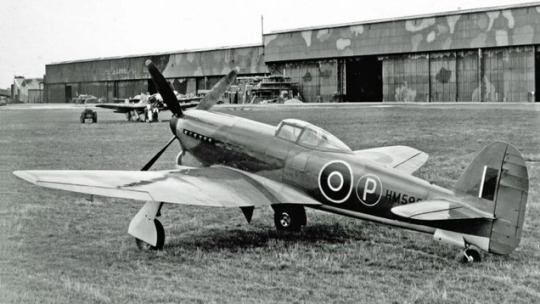

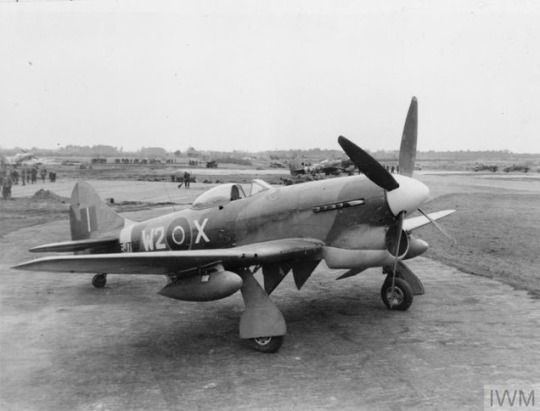

2nd September 1942. First flight of the Hawker Tempest fighter. A major redesign of the Typhoon, the addition of a new laminar flow wing led to a significant improvement in performance. Despite a protracted development process, the Tempest emerged as one of the best piston-engined fighters of the Second World War. Fast, manoeuvrable and heavily armed, the type had an impressive impact despite its late arrival.
Though the first kills claimed by Tempests came over Bf109s on 8th June 1944, its main baptism of fire came during the V-1 offensive against southern England. Here, their high speed of over 400 mph was a key asset. Tempests destroyed over 800 V-1s, almost half of the total destroyed by Allied aircraft. A number of pilots amassed impressive individual totals, including Sqn Ldr Joseph Berry of 501 Squadron, with 59, with seven on 23rd July alone.
As the V-1 offensive declined and German forces retreated, Tempests began to operate from airfields on the continent. Designed as high-performance interceptors, they proved a match for any Luftwaffe aircraft, shooting down over 200 including several jets. However, they were also increasingly used for ground attack missions, with their 4x20mm cannon being highly effective against trains and vehicles. Rockets weren’t carried during the war, while only a small number of sorties were flown with 500lb bombs, shortly before VE Day.
In the postwar period, the standard Mark V Tempests were joined - and partially replaced - by the Mark II, an even faster variant equipped with a Centaurus radial engine. There was also the Mark VI, a specialised fighter-bomber with an improved Napier Sabre engine. However, the widespread introduction of jets soon saw a decline in the Tempest fleet and they had left frontline squadrons by 1950. Aircraft converted to target tugs, however, continued to serve until 1955.
Pictured:
1) The first Tempest to fly was Mark V HM595, which shared the tailfin and original ‘car door’ cockpit of the Typhoon. These would change before the type entered service.
📷 baesystems.com
2) The Commanding Officer of 486 Squadron RNZAF, Squadron Leader J H Iremonger, standing by the cockpit of Hawker Tempest Mark V at Newchurch. This unit was part of 150 Wing, sharing the airfield with 3 and 56 Squadrons.
📷 IWM (HU 92148)
3) Tempest of 80 Squadron RAF equipped with drop tanks at a Dutch airfield in late 1944. The unit was primarily flying armed reconnaissance missions, tasked with attacking any targets they encountered in a given area.
📷 IWM (MH 6860)
4) Hawker Tempest TT Mk.5, carrying a target winch pod under the port wing. These aircraft replaced the much slower types previously used as target tugs, such as the Miles Magister.
📷 IWM (ATP 16813B)
@JamieMctrusty via X
11 notes
·
View notes
Text

A German Me 109 Gustav-2s of Fighter Geschwader 11 - Jever, Germany 1943. This particular variant is fitted with underwing rocket launchers for two 210mm air to air rockets for use against heavy bomber formations
#world war two#1940s#worldwar2photos#history#ww2#wwii#ww2 history#wwii era#world war 2#ww2history#luftwaffe#me109#messerschmitt#me109 Gustav#Gustav#jever#germany#1943
137 notes
·
View notes
Text
RAF Hawker Typhoon fighter-bomber attacking a German train in west Soltau with unguided rockets. 1945
32 notes
·
View notes
Text
by Hugh Fitzgerald
Those who wish Israel ill are up in arms about the IDF’s plan to flood the network of tunnels Hamas has built under Gaza. They are angry because they fear the novel plan will work: Hamas operatives will be flushed out, forced to scurry out of the tunnels and appear above ground, where the IDF can pick them off. The water in the tunnels will also weaken the tunnels by soaking their walls, and the soil just above them, so that they will be more susceptible to eventual collapse; Hamas will never again be able to use them as they have been doing. More on the proposed tunnel flooding, and the reasons given by Hamas and its supporters as why it should not take place, can be found here: “Did the UN Human Rights Council just admit Hamas steals civilian aid? Plus, the dumbest argument yet against flooding tunnels,” Elder of Ziyon, December 15, 2023:
The UN Human Rights X account tweeted something spectacularly stupid:
Israel’s flooding of tunnels with saltwater could have severe adverse human rights impacts, some long term. Goods indispensable to civilian survival could also be at risk, as well as widespread, long-term & severe environmental damage. Civilians must be protected.
Hold on: when they say “Goods indispensable to civilian survival could also be at risk,” doesn’t that mean that they are admitting that Hamas tunnels are warehouses for the aid that the world has been sending into Gaza for the past decades?
Yes, there is no other possible interpretation: those “goods indispensable to civilian survival” — humanitarian aid — are apparently being stored in those tunnels, Hamas having seized them from the shipments of aid meant for all the people of Gaza. Hamas has now stored them inside its tunnels for safe-keeping, for the future care and feeding of Hamas operatives alone. The rest of the Gazans will have to make do with whatever ”goods indispensable to civilian survival” Hamas left behind after taking its massive cut.
Critics of the flooding plan, like Eurasia Review, also say things like “Flooding the tunnels could damage Gaza’s aquifer and soil, if seawater and hazardous substances in the tunnels seep into them.”
“Hazardous substances” means “explosives.” Now, why might there be explosives in the tunnels?… The list of bad things listed in that article that “could” happen if Israel floods the tunnels is almost comical, but the pièce de résistance (so to speak) comes at the end.
Flooding the tunnels could affect the cultural heritage and identity of Gaza, which has a rich and diverse history and culture. The tunnels are part of Gaza’s landscape and memory, and they reflect its character and spirit. Flooding the tunnels could .. affect the cultural expressions and practices of Gaza’s people, such as the art, literature and folklore that are inspired by or related to the tunnels.
Yes, the terror tunnels must be protected because they are an important part of Gaza’s culture!
The tunnels were built by the terror group Hamas to do one thing: help facilitate the terror group’s murderous attacks on Israelis. That is their sole reason for being. The tunnel network has served as a vast underground pedestrian passage, allowing the hiding of weapons, rocket launchers, and Hamas terrorists under most of Gaza, and also allowed the undetected movement underground of weapons and fighters. The tunnels are instruments of murder, not “cultural artifacts” that must be preserved as part of Gaza’s “landscape and memory.” These terror tunnels cost billions of dollars to construct; they likely represent the greatest misallocation of resources in the Middle East since the pyramids were built in the Valley of the Kings.
Do the Gazans really want those ghastly tunnels — which will be left in ruins by the IDF — to be thought of as part of the “cultural heritage and identity of Gaza”? How many Germans like to think of the extermination camps as part of the “cultural heritage and identity” of their country, or aren’t those camps, rather, something of which they are ashamed? The camps are part of their history, but not of their “cultural heritage,” which is a different, and a positive, thing.
How many Russians want to preserve the Soviet labor camps of Vorkuta and Kolyma, as part of their “cultural heritage”? A museum in Moscow, containing testimonies, photographs, and videos, of life in the camps that constituted the Gulag, would be enough to preserve the memory of that hideous aspect of Soviet history.
By all means, the people of Gaza should preserve the memory of the malignant and wasteful tunnels forced on them by Hamas, but they have no need to preserve what remains of those tunnels — 800 of the approximately 1000 that existed have already been destroyed by the IDF —themselves. Must the tunnels really be preserved as part of Gaza’s “landscape and memory,” or are they testimony only to the murderous madness of Hamas, hellbent on murder, and indifferent to the wellbeing of the people of Gaza it has caused? Perhaps one tunnel might be preserved, so that Gazan schoolchildren can visit and see what Hamas wrought in its unhinged unquenchable desire to kill Israelis; that would be more than enough to preserve the memory of the terror group’s madness. Some claim that the tunnels must not be flooded because the resulting damage would affect “the art, literature and folklore that are inspired by or related to the tunnels.” I very much doubt that the “art, literature, and folklore” of Gaza — is there any worth mentioning? — could ever be “inspired” in a good way by those hideous tunnels. Go to it, IDF engineers. Flood those tunnels. Flush the killers out.
32 notes
·
View notes
Text

Scotland and Germany doing a preflight check before Scotland becomes the only one of the Allies to fly a komet (a rocket propelled fighter)
this like many of my random little interaction headcannons is based off of an actual historical anecdote, that being the only non-German to ever fly a komet was a Scottish man just after the war ended
also I’m not gonna lie I did trace the komet because even just normal looking planes are hard as hell to draw.
I should also probably mention GERMANY AND REICH ARE NOT THE SAME PERSON. Germanys like 17 in this image, or he would be were he a human.
I completely forgot to mention but Germany is a trans guy in my HC which is why he's wearing the skirt
15 notes
·
View notes
Text
*ISRAEL REALTIME* - "Connecting the World to Israel in Realtime"
🔹No rockets from Gaza yesterday.
▪️Wall Street Journal: Israel informed the US of its intention to establish a buffer zone one kilometer deep in the Gaza Strip.
▪️Shiite militias of Iraq (Iran supported and weapon supplied) state they have shut down Israel’s Haifa and Ashdod ports via suicide drone attack. “The Islamic resistance in Iraq began the second phase of the naval blockade of the Zionist entity, which includes: a naval blockade in the Mediterranean Sea and the shutdown of its seaports. The siege on it will continue until the blockade of Gaza is lifted and the massacres in the Gaza Strip stop.” This is called believing your own propaganda and assuming that your enemy failing to report on it is enemy lies.
▪️Flood alert: Normal Negev and Dead Sea sites for seasonal rain flow are flooding or expected to flood and must be avoided. Hiking and nature trips should be suspended. The National Center for Flood Prediction: a flow has been detected down Nahal Ergot, it is expected to reach Highway 90 soon.
▪️The compound and neighborhood where 21 soldiers fell was destroyed yesterday afternoon.
🔶 GAZA-HAMAS Front
▪️Heavy fighting continues in Khan Yunis, including airstrikes on enemy terror squads.
▪️Enemy action reports: Violent bombardment in various parts of the Gaza Strip now. Israeli aircraft bombed a group of people (fighters - but we report they were children) on the shore of the sea near Rafah, south of the Gaza Strip. Heavy concentration of IDF forces southwest of Gaza City. IDF tanks firing at buildings next to Nasser Hospital in Khan Yunis, south Gaza.
▪️Gaza Now reports that somehow, nobody knows why (sarcasm), the HUNDREDS of trucks of food aid entering Gaza and sent to north Gaza keep not arriving or arriving mostly empty. Where is the aid going?
🔶 RED SEA-Houthis Front
▪️The Pentagon: Since the 11th of this month, we have destroyed 25 missile launch facilities and more than 20 missiles, drones and radars in Yemen.
▪️Due to the Houthi attacks in the Red Sea, the German shipping company Hapag Lloyd announced the launch of an overland corridor from the shores of the Persian Gulf in the UAE and Saudi Arabia to the Red Sea - bypasses the "Houthi problem" and also significantly shortens shipping time - truck shipping the containers across Saudi Arabia and loading them on ships in the northern Red Sea closer to the Suez Canal.
🔶 REGIONAL War
▪️Iraq: A wave of American attacks in southwestern Iraq and on the way to Qaim (against Iranian backed Shiite militias that have been attacking US bases). The area under attack is Jarp al-Nasr, an area that was taken over by the Iranian Revolutionary Guards (yes, Iran operating in Iraq). Iraqi Hezbollah battalions were also attacked. American planes carried out 5 airstrikes.
🔶 JUDEA-SAMARIA Front
▪️The village of Urif: our forces blew up the house of the terrorist who carried out the deadly shooting attack near the settlement of Eli on June 20 of last year.
20 notes
·
View notes
Text

1943 08 17 Bf 109 Defence of the Reich Aces - Mark Postlethwaite
On 17 August 1943, over 200 B-17 Flying Fortresses of the Eighth Air Force's 1st Bomb Wing were despatched to attack a vital target - the Reich's major ball-bearing factories at Schweinfurt.
The bomber crews were expecting trouble. Their take-off had been delayed by bad weather, and they were a critical three hours or more behind the B-17s of the 4th Bomb Wing, which were heading for Regensburg. They knew the defending Luftwaffe fighters would be fully alerted and ready for them. And they were right.
At Eupen, a small Belgian town less than ten miles from the German border, the bombers 'short-legged' P-47 Thunderbolt escorts were forced to turn back. The Fortresses pressed on alone into Germany. It was the moment the Luftwaffe fighter pilots had been waiting for.
Among the first to attack were the 12 rocket-armed Bf 109G-6s of 5./JG 11 down from Jever. Oberleutnant Heinz Knoke's 'Black 1' was hit by heavy Browning 0.50-calibre machine gun fire as the Staffel jockeyed into position astern of the bombers. With his port wing damaged and left-hand rocket tube (nicknamed a 'stovepipe' by German fighter pilots) shot away, Knoke launched his remaining missile, but without result. Then the rest of the Staffel bored in.
According to Knoke's subsequent account of the action, both Feldwebel Erich Führmann, illustrated here in his 'Black 9', and Feldwebel Wilhelm Fest scored hits on B-17s which blew up in mid-air. However, post-war research suggests that the two 92nd Bomb Group (BG) Flying Fortresses hit in this engagement suffered only slight damage and later fell victim to conventional fighter attack.
Despite his damaged wing, Heinz Knoke took off again later to attack the bombers returning from Schweinfurt. He is credited with bringing down the 305th BG's flak-damaged B-17F 42-30159 Settin' Bull, which crashed in Belgium, before finally writing-off his own 'Black 1' in a forced landing near Rheinbach
14 notes
·
View notes
Text

Iron Cross No. 9 (2021) . Quarterly magazine focussing on German Military History from 1914-1945. Spitfires encountering a V2 rocket on 14 February 1945. You can see the Spitfire on the left clearly has had its wings 'clipped'. The RAF started to do this in 1941 to combat the threat of a new Luftwaffe fighter - the Focke Wulf Fw 190. Clipping the ends off each wing was found to help the Spitfire's acceleration, speed, manoeuvrability and even improved the pilot's field of sight (downwards). Cover by Keith Burns.
#iron cross#keith burns#v2 rocket#supermarine spitfire#2021#14feb#1945#military history#spitfire mk xvi
3 notes
·
View notes
Text

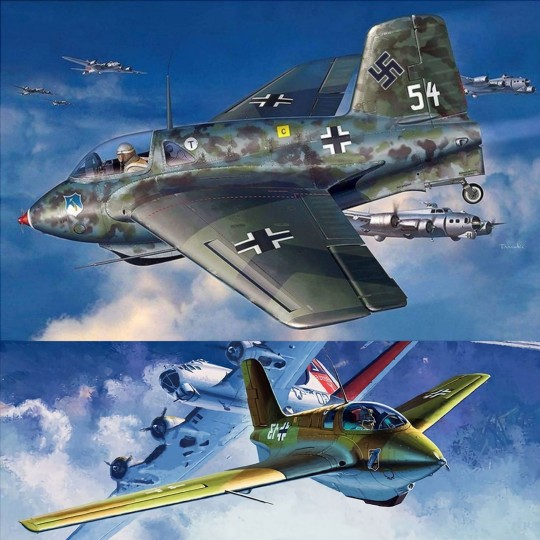
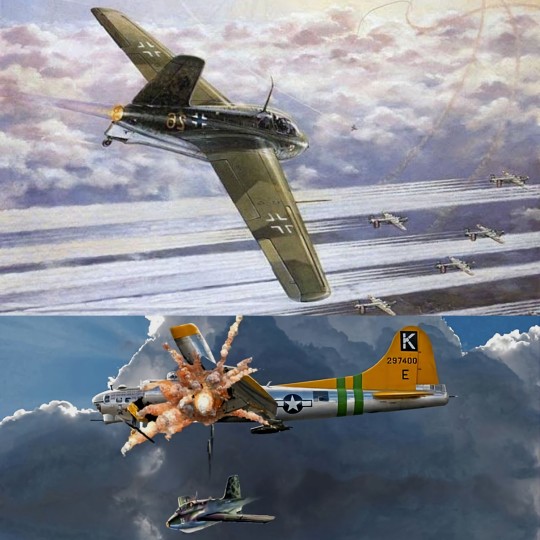
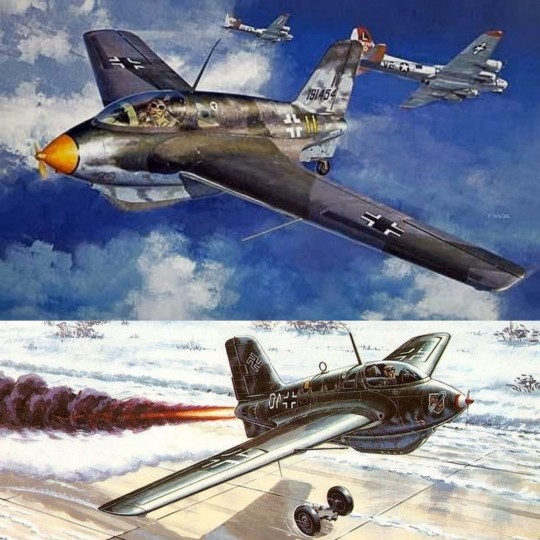
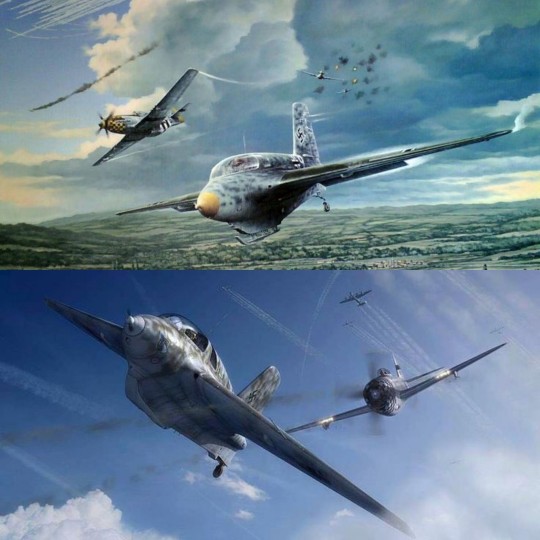
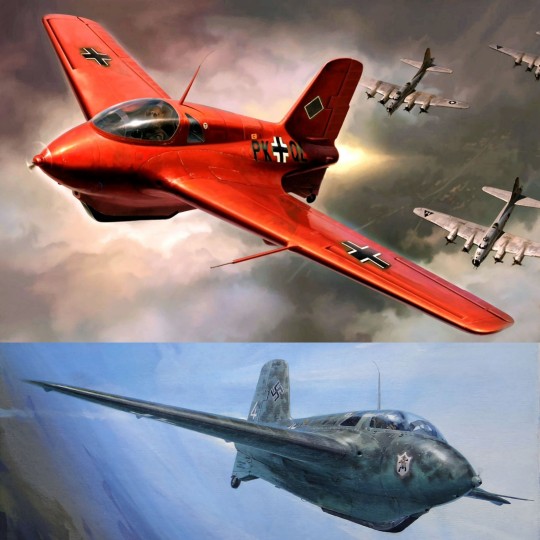
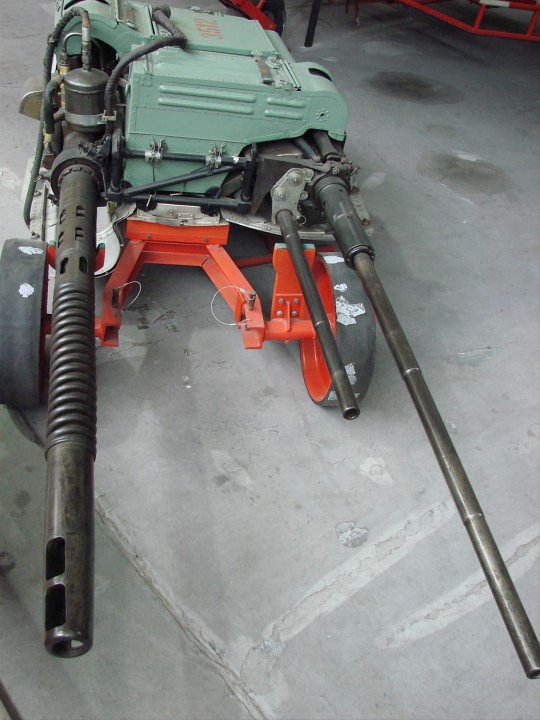


The Messerschmitt Me 163 Komet is a rocket-powered interceptor aircraft primarily designed and produced by the German aircraft manufacturer Messerschmitt. It is the only operational rocket-powered fighter aircraft in history as well as the first piloted aircraft of any type to exceed 1,000 kilometres per hour (620 mph) in level flight.
Credited with the destruction of between nine and 18 Allied aircraft against ten losses.
Armament
Guns:
2 × 30 mm (1.181 in) Rheinmetall Borsig MK 108 cannon with 60 rpg (B-1a)
or
2 × 20 mm (0.787 in) MG 151/20 cannon with 100 rpg (Ba-1 / B-0 pre-production aircraft)
Germany started small-scale combat operations with the Me 163B in May 1944. The Me 163B's unsurpassed velocity was something Allied fighter pilots were at a loss to counter. The Komets attacked singly or in pairs, often even faster than the intercepting fighters could dive. A typical Me 163 tactic was to fly vertically upward through the bombers at 9,000 m (30,000 ft), climb to 10,700–12,000 m (35,100–39,400 ft), then dive through the formation again, firing as they went. This approach afforded the pilot two brief chances to fire a few rounds from his cannons before gliding back to his airfield. The pilots reported it was possible to make four passes on a bomber, but only if it was flying alone. According to the historian Mano Ziegler, Nazi officials were allegedly considering using the Me 163 to directly ram into enemy aircraft in suicide attacks; this desperate tactic was never actually used.
#history#ww2 art#ww2#wwii#wwii art#warship#art#artwork#warbird#fighter#me163#luftwaffe#military aircraft#military art#military aviation#aviation history#aviation#rocketplane#rocket#interceptor
25 notes
·
View notes
Text
How Ratchet & Talwyn's Kids Got Their names
Rockett Apogee: He's named Rockett because his mother Talwyn loves the idea of her first son having a name nearly similar to his father Ratchet. The couple also added an extra T at the end for the fun of it. However, the biggest reason for his name is that a rocket symbolizes such great and fast things including ambition, speed, ascent, rapid growth, progress, exploration, and a high desire to achieve. And his middle name is Kaden, which has multiple meanings: "Companion", "Friend", "Fighter", "Battle", "Round", and "Gentle". The origins are Arabic, German, Scottish, and Irish. Rockett received his middle name in honor of his late paternal grandfather Kaden. Full name of Ratchet and Talwyn's oldest and first son: Rockett Kaden Apogee!
Astera Apogee: Her first name Astera is a girl's name of Greek and Latin origin that means "Star", it can also mean "Celestial Bodies" and "Brightness". Astera is also like the star flower Aster, which I headcanon as Talwyn's favorite flower. She's named Astera due to her parents (mostly Tal) being fond of stars. Plus whenever Ratchet would give Talwyn a bouquet, he would always give her only asters. The flower aster is indeed star-shaped. Plus, I now have a headcanon that the name of Ratchet's late mother was Stella, which also means "Star" in Latin, therefore Astera could also have her name mean "Star" like her late paternal grandmother. And now Astera's middle name is Maxine, and it's of English origin that derives from Latin name Maximus that means "Greatest". Also, the middle name that she gained is, of course, after her maternal grandfather Max Apogee. Full name of Ratchet and Talwyn's middle child and only daughter: Astera Maxine Apogee!
Calix Apogee: Finally, Calix. His name means "Very Handsome", "Very Wonderful", and "Very Beautiful" in Greek. As for his middle name, it is Zander, which is also Greek with the meaning of "Defender of People/Men". It's quite similar to Alexandros that is derived from words alexein meaning "To Defend" and andros meaning "Man" and "Warrior". However, there is a very beloved reason for why Calix's first name starts with a C while his middle name starts with a Z. First off, Zander, his middle name starts with a Z as tribute to Zephyr (RIP). And secondly, Calix has a C name because of not only as a dedication to Cronk (may he also rest in peace), but it was especially because of Clank who's the number one reason for his second adoptive nephew's name starting with a C. While It's for both Cronk and Zephyr, it is the ultimate honor for uncle Clank! Full name of Ratchet and Talwyn's youngest and second son: Calix Zander Apogee!
#Ratchet and Clank#Ratchet & Clank#RaC#R&C#Ratchet#Ratchet the Lonbax#Ratchet Apogee#Talwyn Apogee#TalChet#TalChet Fankids#Rockett Apogee#Astera Apogee#Calix Apogee#Ratchet x Talwyn#Kaden#Ratchet's Mom#Max Apogee#Cronk#Zephyr#Clank#R&C Sweets#Ratchet & Clank Next Generation#TalChet Family
6 notes
·
View notes
Text
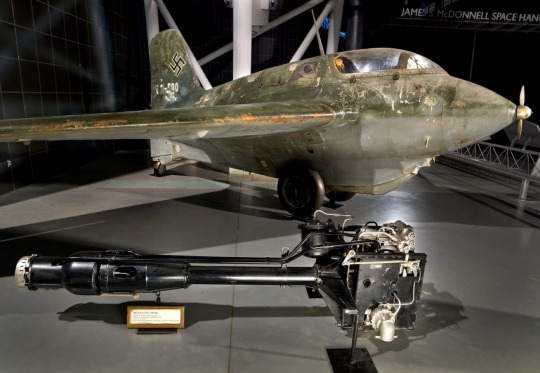
80 years ago today, the German Messerschmitt Me 163 Komet flew its first operational sortie. It was the first and only tailless rocket-powered interceptor to see operational service. s.si.edu/3SOda4o
@airandspace via X
10 notes
·
View notes